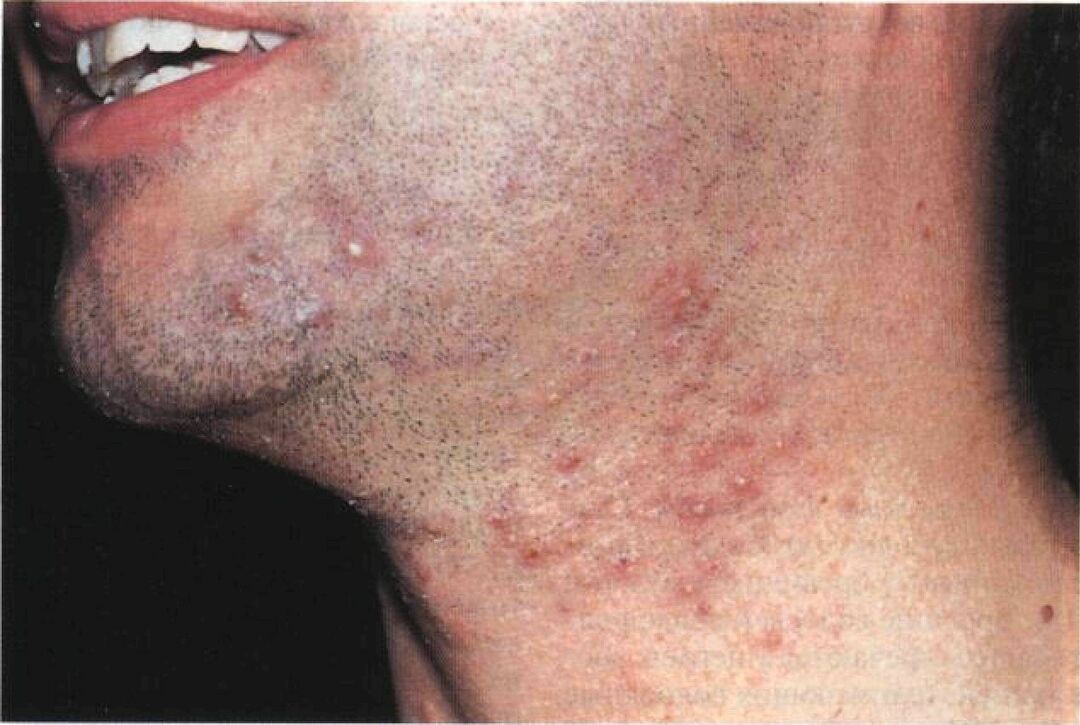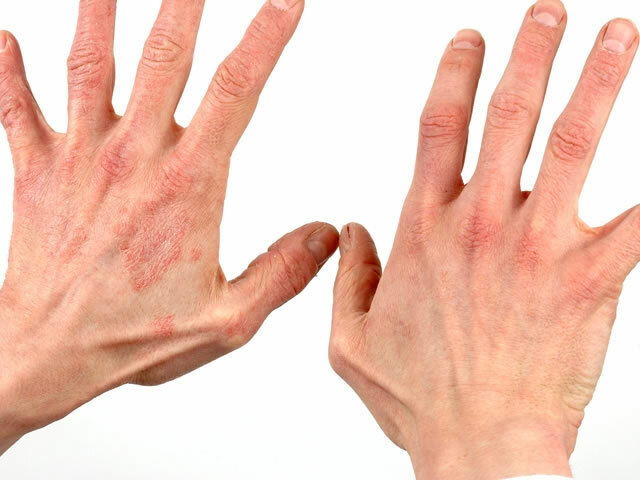Blooming of babies: causes, symptoms, differential diagnosis, treatment
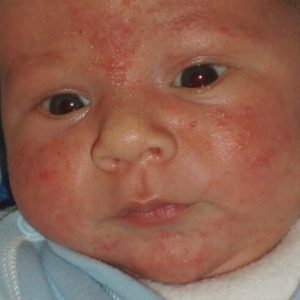
The phenomenon, which is popularly called "flowering babies", is nothing more than neonatal cephalic pustulosis, or a hormone rash.According to statistics, it appears in almost every fourth baby.
Common synonyms:
- millet specks;
- acne neonates;
- millet newborn;
- a three-week rash.
This condition does not pose a threat to the health of the baby, therefore the parents of the child have no particular cause for concern.
Table of contents: Causes of acne in newborns How does hormone rash appear Diagnosis of newborn acne What kind of treatment is required for blooming newborns?Causes of the appearance of acne in newborns
Blooming of newborns is usually not the result of improper skin care for the baby, and is in no way associated with infections or a hypersensitivity reaction( allergy).
The appearance of such rashes on the skin is the result of fluctuations in the hormonal background, which are reflected in the activity of imperfect sebaceous gland glands.Their dysfunction is caused by an increased concentration of estrogens.The child receives these female sex hormones from the mother;Before birth, they come with blood through the umbilical cord, and then - with breast milk.As the level of estrogen decreases, flowering stops.
Note: is believed that the leading factor contributing to the appearance of such a rash in newborn boys is precisely the intake of estrogens with mother's milk.In girls, the increased functional activity of the sebaceous glands contributes to bloom.
The "three-week rash" is quite typical for the period of adaptation and purification from the parent hormones.It is regarded as a variant of the physiological norm.
Usually, the flowering of newborns begins to manifest in the second and third week of life, and completely passes by the 3rd month.The average duration of the phenomenon varies from three weeks to one and a half months.
Important: A possible cause of acne development in a baby may be an inadequate level of hygiene, but such a problem can appear at any age.Acne develops when the ducts of the sebaceous glands are clogged with dust and microscopic scales of the epithelium.
As a hormone rash appears in infants
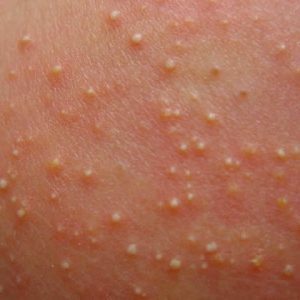 In this condition, small red elements( pustules) with whitish or white-yellow spots similar to pustules appear on the baby's skin.Rashes can merge into groups.Comedones, i.e. white or black papules, indicating a blockage of the duct of the sebaceous gland, are usually not detected.The primary localization of the rash is the face area( cheeks, forehead, eyelids, chin).Primary elements can also be found on the neck, behind the ears, and the upper part of the trunk, and in the male infants - and on the genitals.In parallel with the appearance of characteristic skin rashes, there are usually abundant discharges from the sebaceous glands.The skin of the face area is covered with a thin fatty film.Pimples on the trunk are smaller than on the face.
In this condition, small red elements( pustules) with whitish or white-yellow spots similar to pustules appear on the baby's skin.Rashes can merge into groups.Comedones, i.e. white or black papules, indicating a blockage of the duct of the sebaceous gland, are usually not detected.The primary localization of the rash is the face area( cheeks, forehead, eyelids, chin).Primary elements can also be found on the neck, behind the ears, and the upper part of the trunk, and in the male infants - and on the genitals.In parallel with the appearance of characteristic skin rashes, there are usually abundant discharges from the sebaceous glands.The skin of the face area is covered with a thin fatty film.Pimples on the trunk are smaller than on the face.
Important : in rare cases, acne appears before birth.There are cases when hormone rash persists in 6-month and even one-year-old children, and in severe cases - and a little bit longer.
The individual disappearance of the rashes occurs as the digestive system matures and the overall adaptation of the baby's organism to the environment.
Important: rash, unlike allergic rashes, does not cause the baby any trouble.
Diagnosis of neonatal acne
Parents who have noticed a baby's rash, one way or another, need to consult a pediatrician.Red pimples may well be one of the clinical manifestations of food allergies.A qualified pediatrician should be able to conduct a differential diagnosis of blooming infants with a rash, which indicates a particular pathology.
Most often, acne in newborns is confused with diathesis, which can be the result of inaccuracies in the diet of the nursing mother.
Note: diathesis is not a disease, and not a diagnosis, but a term denoting a child's increased tendency to inflammatory and allergic diseases.
There is reason to suspect diathesis if the appearance of the rash coincided with the appearance, for example, of intestinal colic or other problems on the part of the digestive system( increased gas formation, vomiting, diarrhea, etc.).
The main difference between flowering and allergic rashes is the localization of the rash.When hypersensitivity reaction, primary elements are found throughout the body of the child.Externally, individual pimples are different;With allergies there are no white tops in the center.Against the background of allergic inflammation, the restless behavior of the child is noted, as the skin itches. Sleep disturbances and decreased appetite are also common, that is not at all characteristic of flowering babies.
Important: should be aware that hormone rash never peels off!
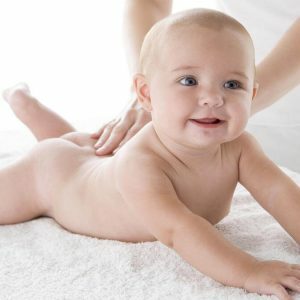 If neonatal pustulosis is mistaken for an allergy or a manifestation of another disease, the infants are unreasonably prescribing pharmacological agents, which negatively affects the child's body.
If neonatal pustulosis is mistaken for an allergy or a manifestation of another disease, the infants are unreasonably prescribing pharmacological agents, which negatively affects the child's body.
Hormonal rash should also be distinguished from sweats.When the pancreas appear small pimples by the type of subcutaneous tubercles.They deliver the baby a strong discomfort, because they constantly itch.It is important to take into account localization;Sweating is most often developed in the groin, gluteal folds, in the armpits, as well as in the elbow and knee folds.
Differential diagnosis of a three-week rash is conducted with an infectious disease - pyoderma of newborns.
What kind of treatment is required for blooming newborns?
 Since neonatal bloom is, in fact, completely normal, in most cases no specific therapy is needed.After a short period of time the rashes disappear by themselves, and in their place there is not even the slightest trace.
Since neonatal bloom is, in fact, completely normal, in most cases no specific therapy is needed.After a short period of time the rashes disappear by themselves, and in their place there is not even the slightest trace.
Treatment is required only for very severe varieties of hormone rash.In such situations, a specialist dermatologist or endocrinologist is required.
Never expose white dots on the skin of a baby, as such actions can lead to infectious complications and cause scarring.Do not also treat the pustules with alcohol solutions and other antiseptics( manganese, furacilin, etc.).Competent care for the tender skin of a newborn assumes only ensuring its dryness and purity.
It is advisable to wipe the rash with broths of medicinal herbs such as sequins, marigolds or chamomiles, but only after carrying out tests to make sure that all phytopreparations are not allergenic.On the recommendation of a doctor, you can lubricate the pustules with Bapanten ointment.Treatment with this agent is carried out once every 3-4 days for drying the skin elements.
With prolonged persistence of pustules, pediatricians prescribe agents for topical topical application - ointments, the active ingredient of which is ketoconazole.To create a reliable barrier against microbes, with abundant rashes, antiseptic ointments with zinc are shown.
Please note: categorically contraindicated anti-acne ointment because they create an airtight film on the baby's skin, which only worsens the situation.
It is important to maintain the room in an impeccable cleanliness and optimum humidity.Proper nutrition of the nursing mother promotes rapid adaptation of the infant's gastrointestinal tract and normalization of the hormonal background of the baby.
The different types of rashes in children are described in more detail by Dr. Komarovsky:
Plisov Vladimir, medical reviewer

